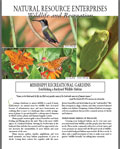Game Animals
Non-game Animals
Habitat
Bat
Various species
- 45 species in North America
- Can be found in many different habitats
- Majority are insectivorous, helping to control insect populations
- Decline of bat populations due to natural and human factors
Species Description: Bats
Bats are an important part of forested ecosystems, deserts, and rangelands and contribute to a region’s biodiversity. Bats exist in many different types of habitats like forests, deserts, cities and swamp lands. Their habitats need to include dark, protected places to hide from predators, sleep during and to hibernate in during the winter.
The majority of North American bat species are insectivorous and serve as insect-controllers and pollinators. They typically consume more than 50 percent of their body with each night, consuming moths, flies, mosquitoes, beetles and other insects. The Brown Bat, one of the most common species, can capture 600 mosquitoes in one hour. Nectar-feeding and fruit bats pollinate more than 130 types of plants.
Forty-five species of bats have been found in the United States and seven of them have been listed as threatened or endangered. The decline of bat populations is due to natural factors like flooding, freezing and diseases. Human factors, however, are the main cause of their decline. These factors include eradication, cave commercialization, deforestation, strip mining and improper use of pesticides.

Mississippi Recreational Gardens: Establishing a Backyard Wildlife Habitat (PDF)
Mississippi State University Extension Service, Natural Resource Enterprises Program
All wildlife requires food, water and shelter to survive. This publication discusses providing those necessities in a backyard environment. Detailed information is given on how to attract birds, hummingbirds, butterflies, bats, snakes, lizards, toads and frogs. Information is also provided on controlling deer, rodents, and other animals that are considered pests. Management tips are given for making your backyard the best habitat possible including an example and how to create a trail.
Bats: Ecologically Important Mammals (PDF)
Animal Welfare Institute Endangered Species Handbook
Bats are important to the environment as pollinators and insect killers. This publication includes a list of North American bat species and identifies their distribution and threat level. A list of other resources on bats is also included.
Bats Found in Mississippi (PDF)
Mississippi Department of Wildlife, Fisheries and Parks
A listing of the bats found in Mississippi.

